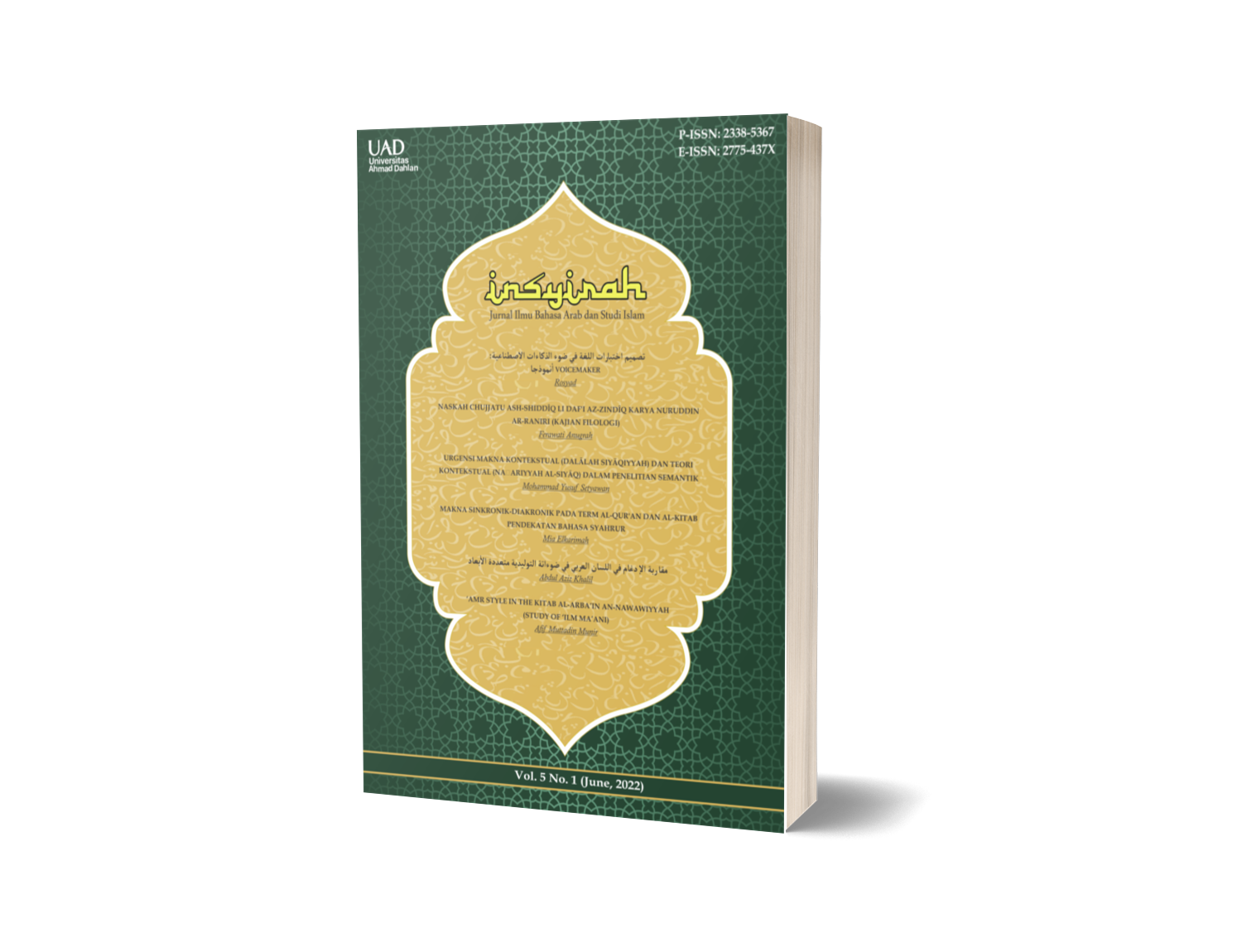The Variation of Arabic Teaching Method at SMPIT Tahfidz Shohibul Qur’an Kampar
DOI:
https://doi.org/10.26555/insyirah.v7i1.10368Keywords:
Variation, Teaching method, Arabic learningAbstract
This descriptive qualitative research aims to determine the method of teaching Arabic at SMPIT Tahfiz Shohibul Qur'an Kampar. Data collection from school principals and Arabic teachers used interview techniques, observation and documentation regarding Arabic teaching methods carried out at SMPIT Tahfiz Shohibul Qur'an Kampar. This research shows that there are several methods used in learning Arabic, including; 1) the method used is istima' and kitabah; 2) the method used in learning Arabic is using social media as a learning medium, and utilizing technology such as TV and others. The obstacle faced by the SMPIT Shohibul Qur'an school is the lack of adequate teachers in teaching Arabic, because of the lack of teachers in this field the competence to teach Arabic is reduced. So that only methods that already exist are used. The conclusion this research is 1) the method used is istima' and kitabah; 2) the method used in learning Arabic is using social media as a learning medium, and utilizing technology such as TV and others; 3) The obstacle faced by the SMPIT Shohibul Qur'an school is the lack of adequate teachers in teaching Arabic, because of the lack of teachers in this field the competence to teach Arabic is reduced. So that only methods that already exist are used.
References
Aldawood, Z., Hand, L., & Ballard, E. (2023). Language learning environments for Arabic- speaking children in New Zealand : Family demographics and children ’ s Arabic language exposure Family demographics and children ’ s Arabic language exposure. SPEECH, LANGUAGE AND HEARING, 26(4), 266–277. https://doi.org/10.1080/2050571X.2023.2212537
Asy’ari, M. (2018). Metode, Sistem dan Prinsip Pembelajaran Bahasa Arab yang Inovatif. An Nabighoh: Jurnal Pendidikan Dan Pembelajaran Bahasa Arab, 20(02), 295–299. https://doi.org/10.32332/an-nabighoh.v20i02.1465
Backfisch, I., Sibley, L., Lachner, A., Tulku, K., Hische, C., & Scheiter, K. (2024). Enhancing pre-service teachers ’ technological pedagogical content knowledge ( TPACK ): Utility-value interventions support knowledge integration. Teaching and Teacher Education, 142(February), 104532. https://doi.org/10.1016/j.tate.2024.104532
Baroroh, R. U., & Rahmawati, F. N. (2020). Metode-Metode Dalam Pembelajaran Keterampilan Bahasa Arab Reseptif. Urwatul Wutsqo: Jurnal Studi Kependidikan Dan Keislaman, 9(2), 191. https://doi.org/10.54437/urwatulwutsqo.v9i2.181
Cutter, M. G., Filik, R., & Paterson, K. B. (2022). Do readers maintain word-level uncertainty during reading ? A pre-registered replication study. Journal of Memory and Language, 125(April), 104336. https://doi.org/10.1016/j.jml.2022.104336
Fahrurrozi, A. (2014). Pembelajaran Bahasa Arab : Problematika Dan Solusinya. ARABIYAT: Jurnal Pendidikan Bahasa Arab Dan Kebahasaaraban, 1(2), 161–180. https://doi.org/10.15408/a.v1i2.1137
Geel, M. Van, Keuning, T., & Safar, I. (2022). Teaching and Teacher Education : Leadership and Professional Development How teachers develop skills for implementing differentiated instruction : Helpful and hindering factors. Teaching and Teacher Education: Leadership and Professional Development 1, 1(February), 1–11. https://doi.org/10.1016/j.tatelp.2022.100007
Hidayat, N. S. (2012). Problematika Pembelajaran Bahasa Arab. Jurnal Pemikiran Islam, 37(1), 40–58. https://doi.org/10.47435/naskhi.v2i1.290
Jubran, S. M. (2023). Teachers ’ Perspectives of the Sudden Shift Towards Online Learning : Challenges and Future Lessons. Journal of Language Teaching and Research, 14(1), 239–248.
Kamsinah, K. (2008). Metode Dalam Proses Pembelajaran: Studi Tentang Ragam Dan Implementasinya. Lentera Pendidikan : Jurnal Ilmu Tarbiyah Dan Keguruan, 11(1), 101–114. https://doi.org/10.24252/lp.2008v11n1a8
Li, P., Mayer, D., & Malmberg, L. (2024). Student engagement and teacher emotions in student-teacher dyads : The role of teacher involvement. Learning and Instruction, 91(December 2022), 101876. https://doi.org/10.1016/j.learninstruc.2024.101876
Liu, N. F., Lin, K., Hewitt, J., Bevilacqua, M., Petroni, F., & Paranjape, A. (2024). Lost in the Middle : How Language Models Use Long Contexts. Transactions of the Association for Computational Linguistics, 12, 157–173.
Mahmudah, & Paramita, N. P. (2023). Transformasi Pembelajaran Bahasa Arab di Era Digital: Tantangan dan Peluang dalam Pendidikan. Prosiding Pertemuan Ilmiah Internasional Bahasa Arab, 14(1), 841–858.
Mandalika. (2023). Analisis Strategi dan Metode Pembelajaran Bahasa Arab di Asrama Bahasa Arab Manhalun Nabighin. Jurnal Sathar, 1(1), 3. https://doi.org/10.59548/js.v1i1.38
Nafilah, S. A., Hamidi, S. R., & Maulidiyah, L. (2024). Arabic Language Learning Methods in The Digital Era. I J A Z A R A B I : J o u r n a l o f A r a b i c L e a r n i n G, 7(1), 286–295.
Nasrulloh, M. F., Nasoih, A. K., Satiti, W. S., & Afifa, S. K. (2020). Mengatasi Problematika Pembelajaran Bahasa Arab melalui Pelatihan dan Permainan Bahasa Arab. Jurnal Pendidikan: Jurnal Pengabdian Masyarakat, 1(1), 28–35. https://ejournal.unwaha.ac.id/index.php/abdimaspen/article/view/104 0
Oppi, P., & Eisenschmidt, E. (2022). Teaching and Teacher Education : Leadership and Professional Development Developing a professional learning community through teacher leadership : A case in one Estonian school. Teaching and Teacher Education: Leadership and Professional Development, 1(April), 100011. https://doi.org/10.1016/j.tatelp.2022.100011
Pandor, J. (2023). The Motivational Orientations of Undergraduate Students to Learn Arabic in a Dubai Private. Journal of Language Teaching and Research, 14(1), 96–107.
Pegrum, M., & Lan, Y. (2023). Extended reality ( XR ) in language learning : Developments and directions. Language Learning & Technology, 27(3), 1–5.
Rafsanjani, H., Zubaidillah, M. H., & Nuruddaroini, M. A. S. (2022). Problematika Mahasiswa dalam Manajemen Skill Berbahasa Arab pada Perguruan Tinggi di Kalimantan. Jurnal Basicedu, 6(3), 5166–5180. https://doi.org/10.31004/basicedu.v6i3.3072
Ramponi, A. (2024). Language Varieties of Italy : Technology Challenges and Opportunities. Transactions of the Association for Computational Linguistics, 12, 19–38.
Shin, D., & Lee, J. H. (2023). Can ChatGPT make reading comprehension testing items on par with human experts ? Language Learning & Technology, 27(3), 27–40.
Soliman, R., & Khalil, S. (2022). International Journal of Bilingual Education and The teaching of Arabic as a community language in the UK. International Journal of Bilingual Education and Bilingualism, May, 1–12. https://doi.org/10.1080/13670050.2022.2063686
Yusuf Aditya, D. (2016). Pengaruh Penerapan Metode Pembelajaran Resitasi terhadap Hasil Belajar Matematika Siswa. SAP (Susunan Artikel Pendidikan), 1(2), 172–173. https://doi.org/10.30998/sap.v1i2.1023
Zhang, T., Ladhak, F., Durmus, E., & Liang, P. (2024). Benchmarking Large Language Models for News Summarization. Transactions of the Association for Computational Linguistics, 12, 39–57.
Downloads
Published
Issue
Section
License
Copyright (c) 2024 Hikmatul Khusniah, Hakmi Wahyudi, Nandang Sarip HIdayat

This work is licensed under a Creative Commons Attribution-ShareAlike 4.0 International License.









